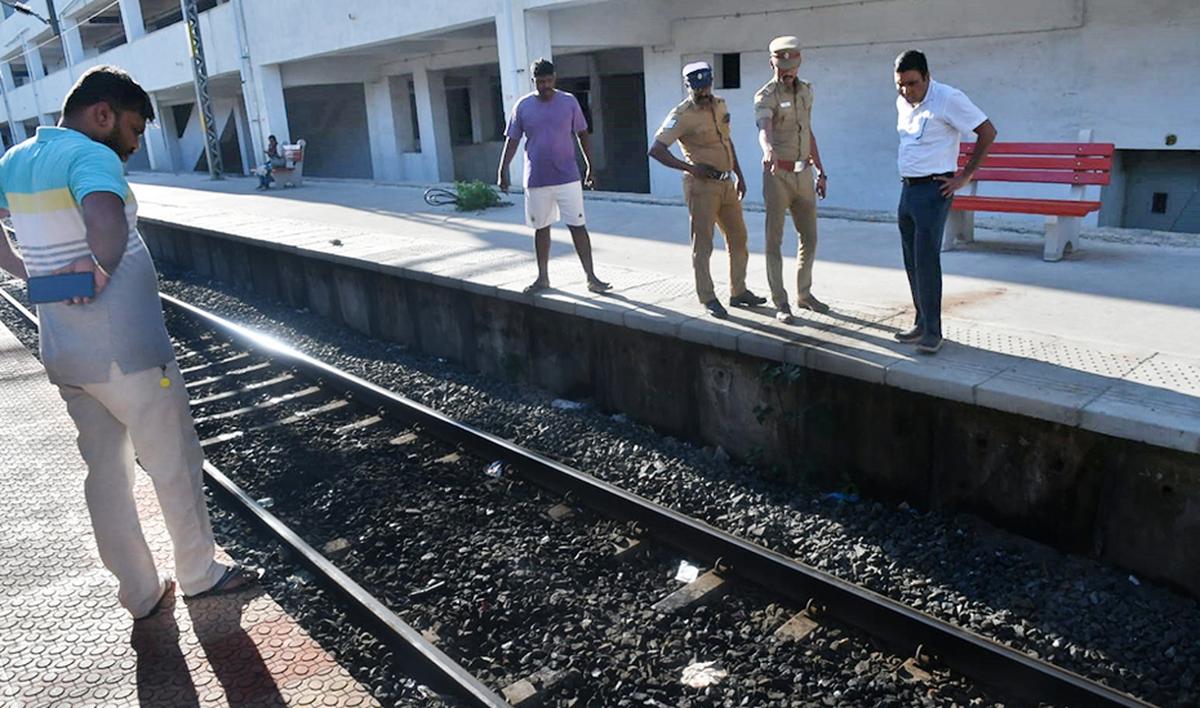
St. Thomas Mount murder | Victim was known to the accused, he attacked her during spat in the past
The Hindu
Both were residents of police quarters in Alandur; special teams constituted to trace the accused; police analyse CCTV visuals, hold inquiries
M. Sathya, 20, who was pushed in the path of a moving train at St. Thomas Mount station on Thursday and killed, was known to the accused D. Sathish, 23. She was the daughter of a woman constable. The father of Sathish is a retired special sub-inspector of police. Both were living at the police quarters at Alandur.
Police sources said the two had been in love and she had avoided him recently. Both had a dispute that their families were aware of.
Around noon, Sathya and her classmate came to the railway station to take a train to T. Nagar. Sathish followed Sathya and picked a heated argument with her on the platform. He suddenly pushed her in front of the train heading from Tambaram to Egmore. She was decapitated. He fled the spot.
Personnel of the Government Railway Police from the Tambaram and Mambalam stations recovered the body.
Additional Director-General of Police, Railways, V. Vanitha told The Hindu, “Special teams have been constituted to trace the accused. We will secure him soon.” Following the incident, the Government Railway Police and the Railway Protection Force increased the protection at the railway stations.
A special police team interrogated a friend of Sathya and the parents of the accused. They also analysed CCTV camera footage to find out his behaviour and whereabouts. The body was sent to Rajiv Gandhi Government General Hospital for post-mortem.
The police said the accused had fought with the victim a few months ago and attacked her. The police let him off with a warning.

“Writing, in general, is a very solitary process,” says Yauvanika Chopra, Associate Director at The New India Foundation (NIF), which, earlier this year, announced the 12th edition of its NIF Book Fellowships for research and scholarship about Indian history after Independence. While authors, in general, are built for it, it can still get very lonely, says Chopra, pointing out that the fellowship’s community support is as valuable as the monetary benefits it offers. “There is a solid community of NIF fellows, trustees, language experts, jury members, all of whom are incredibly competent,” she says. “They really help make authors feel supported from manuscript to publication, so you never feel like you’re struggling through isolation.”

Several principals of government and private schools in Delhi on Tuesday said the Directorate of Education (DoE) circular from a day earlier, directing schools to conduct classes in ‘hybrid’ mode, had caused confusion regarding day-to-day operations as they did not know how many students would return to school from Wednesday and how would teachers instruct in two modes — online and in person — at once. The DoE circular on Monday had also stated that the option to “exercise online mode of education, wherever available, shall vest with the students and their guardians”. Several schoolteachers also expressed confusion regarding the DoE order. A government schoolteacher said he was unsure of how to cope with the resumption of physical classes, given that the order directing government offices to ensure that 50% of the employees work from home is still in place. On Monday, the Commission for Air Quality Management in the National Capital Region and Adjoining Areas (CAQM) had, on the orders of the Supreme Court, directed schools in Delhi-NCR to shift classes to the hybrid mode, following which the DoE had issued the circular. The court had urged the Centre’s pollution watchdog to consider restarting physical classes due to many students missing out on the mid-day meals and lacking the necessary means to attend classes online. The CAQM had, on November 20, asked schools in Delhi-NCR to shift to the online mode of teaching.









